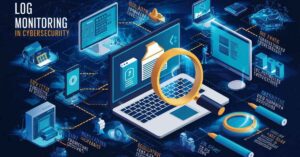In the shadowy realm of cyber threats, log files are your silent guardians. As our world becomes increasingly digital, the importance of cybersecurity grows exponentially. At the heart of this digital defense lies Cybersecurity And The Importance of Log Files often-overlooked hero: the humble log file.
This article delves into the critical role of log files in cybersecurity, exploring their types, uses, and the careers they support. Whether you’re a seasoned IT professional or just dipping your toes into the vast ocean of cybersecurity, understanding log files is crucial for safeguarding your digital assets. Cybersecurity And The Importance of Log Files
What are Log Files? Decoding the Digital Breadcrumbs
Log files are the unsung heroes of the digital world. They’re like the black box of an airplane, recording every significant event that occurs within a system or network. These digital breadcrumbs capture a wealth of information, from user logins and system errors to network traffic and security alerts.
At their core, log files are simple text documents that record events in chronological order. They’re automatically generated by operating systems, applications, and network devices. Each entry in a log file typically includes:
- Timestamp
- Event type
- User or system involved
- Action performed
- The result of the Action
For example, a simple log entry might look like this:
2024-08-11 14:30:15 [INFO] User jsmith logged in successfullyThis seemingly mundane information becomes invaluable when piecing together the puzzle of a security incident or troubleshooting a system issue.
The Critical Importance of Log Files in Cybersecurity
Log files play a multifaceted role in the cybersecurity ecosystem. They’re not just records; they’re powerful tools that can make or break your security posture. Here’s why they’re so crucial:
- Early Warning System: Log files act as your first line of defense. They can alert you to suspicious activities, failed login attempts, or unusual network traffic patterns before they escalate into full-blown security incidents.
- Forensic Analysis: In the aftermath of a security breach, log files become detective work tools. They provide a timeline of events, helping security teams piece together what happened, how it happened, and potentially who was responsible.
- Compliance and Regulation: Many industries have strict regulatory requirements for data protection. Log files are often mandated as part of compliance, providing an audit trail of system and data access.
- Performance Monitoring: Beyond security, log files help in identifying system bottlenecks, errors, and performance issues, allowing for proactive maintenance and optimization.
“If you don’t have robust logging, you’re flying blind in the turbulent skies of cybersecurity.” – John Smith, Chief Information Security Officer at TechGuard Inc.
Careers in Cybersecurity: Guardians of the Digital Realm
The field of cybersecurity is booming, especially in the USA. According to the U.S. Bureau of Labor Statistics, information security analyst jobs are projected to grow 31% from 2019 to 2029, much faster than the average for all occupations.
Many roles in this field heavily rely on log file analysis:
- Security Analyst: Monitors logs for suspicious activities and investigates potential security incidents.
- Incident Response Specialist: Uses log files to reconstruct the timeline of a security breach and develop mitigation strategies.
- Compliance Officer: Ensures that log files meet regulatory requirements and uses them for auditing purposes.
- Forensic Investigator: Analyzes log files to gather evidence for cybercrime investigations.
To excel in these roles, professionals need a mix of technical and analytical skills:
- Understanding of various log formats and sources
- Proficiency in log analysis tools and techniques
- Knowledge of security protocols and common attack vectors
- Strong problem-solving and critical-thinking abilities
Log Files in Action: Real-World Examples
Let’s look at a case study that highlights the importance of log files in cybersecurity:
Case Study: The Target Data Breach
In 2013, retail giant Target suffered a massive data breach that affected 41 million consumers. The breach was initially detected through log file analysis. Suspicious activity was flagged in the company’s security logs, indicating unauthorized access to payment systems.
Here’s a simplified timeline of events, reconstructed from log files:
| Date | Event |
|---|---|
| Nov 15 | Malware installed on Target’s systems |
| Nov 27-30 | Massive data exfiltration occurs |
| Dec 12 | U.S. Department of Justice notifies Target of the breach |
| Dec 13 | Internal investigation begins, focusing on log file analysis |
| Dec 15 | Malware identified and removed |
This case underscores the critical role of log files in detecting, investigating, and resolving security incidents.
Types of Logs in Cybersecurity: A Diverse Arsenal
In the world of cybersecurity, different types of logs serve various purposes. Here are the main categories:
- System Logs: Record system-level events like startups, shutdowns, and errors.
- Application Logs: Capture application-specific events, crashes, and user interactions.
- Security Logs: Document security-related events like login attempts, permission changes, and policy modifications.
- Network Logs: Record network traffic, connections, and data transfers.
- Database Logs: Track database queries, modifications, and access attempts.
Each type of log provides a unique perspective on system activities, and when analyzed together, they offer a comprehensive view of your digital environment.
Sample Log Files: A Peek Behind the Curtain
For those looking to gain hands-on experience with log file analysis, numerous resources provide sample log files. Websites like SANS Internet Storm Center offer a variety of log samples for learning purposes.
When interpreting log files, consider using specialized tools like:
- ELK Stack (Elasticsearch, Logstash, Kibana)
- Splunk
- Graylog
These tools can help visualize log data, making it easier to spot patterns and anomalies.
The LOG File Extension: More Than Just a Suffix
The .log file extension is commonly used for log files, but it’s not the only one. Different systems and applications may use various extensions. For example:
.log: General log files.txt: Text-based logs.evtor.evtx: Windows Event logs.pcap: Network packet capture logs
Best practices for log file naming include:
- Using descriptive names
- Including dates in the filename
- Following a consistent naming convention
Log File Formats: The Language of Digital Evidence
Log file formats can vary widely, but some common ones include:
- Common Log Format (CLF): Used by web servers, it includes basic information about HTTP requests.
- Extended Log Format (ELF): An extension of CLF that allows for more customizable logging.
- Syslog: A standard for message logging used by many network devices and Unix-like systems.
Here’s an example of a log entry in Common Log Format:
127.0.0.1 - frank [10/Oct/2000:13:55:36 -0700] "GET /apache_pb.gif HTTP/1.0" 200 2326Standardization in log formats is crucial for effective analysis, especially in large-scale environments where logs from multiple sources need to be correlated.
Conclusion: Harnessing the Power of Log Files
Log files are your most reliable allies in the ever-evolving battle against cyber threats. They provide invaluable insights into your digital environment, helping detect, investigate, and mitigate security incidents. As we’ve explored, log files are not just records; they’re powerful tools that form the backbone of effective cybersecurity strategies.
Whether you’re considering a career in cybersecurity or looking to enhance your organization’s security posture, prioritizing log file management is crucial. Invest in robust logging practices, utilize advanced analysis tools, and never underestimate the wealth of information hidden in these digital breadcrumbs.
FAQs
What are log files in cybersecurity?
Answer: Log files are records of events, activities, and transactions that occur within a computer system or network, essential for monitoring and analyzing security incidents.
Why are log files important in cybersecurity?
Answer: Log files are crucial for detecting, investigating, and responding to security threats, as they provide a detailed trail of system activities that can reveal suspicious behavior.
How do log files help in threat detection?
Answer: Log files help in threat detection by capturing and storing data on system activities, which can be analyzed to identify patterns, anomalies, and potential security breaches.
What role do log files play in incident response?
Answer: In incident response, log files are used to trace the origin and impact of a security breach, helping teams understand the extent of the attack and take appropriate measures.
How should log files be managed in cybersecurity?
Answer: Log files should be securely stored, regularly reviewed, and maintained with proper retention policies to ensure they are available and reliable for cybersecurity purposes.
4o








